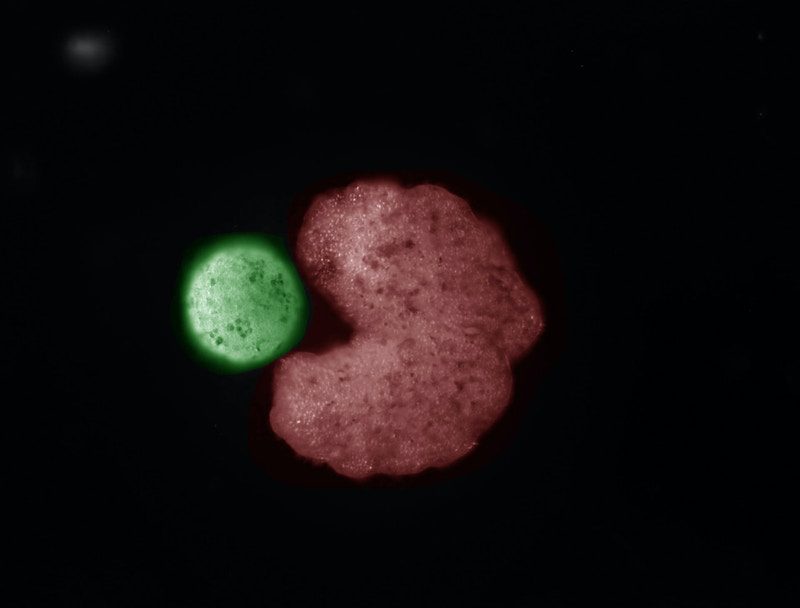The world’s first “living” robots have learned to reproduce—an incredible breakthrough in regenerative science. Teams from the University of Vermont, Tufts, and Harvard have designed the creatures, called Xenobots.
The Xenobots are an extremely complicated organism, first developed a year ago from African clawed frog embryos. According to a press release by UVM, the Xenobots behave in a way never observed before by scientists.
“They’re neither a traditional robot nor a known species of animal. It’s a new class of artifact: a living, programmable organism,” says UVM robotics expert Joshua Bongard. A supercomputer programmed the “consciousness” of the organisms at UVM.
The supercomputer ran thousands of algorithms to single out the best way to program a lifeform into specific tasks. By using set guidelines on how biological systems operate, the supercomputer found the most effective shapes that the embryos could form.
The Smithsonian states that scientists then “reconfigured them Frankenstein-style using tiny tweezers and an electrode into the shape designed by the supercomputer.”
No genetic modification was involved, nor did the scientists create a traditional metal-like robot organism. Using supercomputer AI, real frog cells were manipulated into shapes to perform tasks at different efficiencies. The research was published in January 2020 in the Proceedings of the National Academy of Sciences.
Soon researchers reported that the desired configuration, a spherical-like shape, could be self-sufficient. These first Xenobots would be observed as they navigated throughout the petri dish and could repair themselves after being damaged, UVM stated.
Immediately, the possible real-world applications became alluring to scientists on the project. Michael Levin, director of the Tuft’s Center for Regenerative and Developmental Biology, said that in the future, the Xenobots can be used to “search out nasty compounds or radioactive contamination, gather microplastic in the oceans or travel in arteries to scrape out plaque.”
However, scientists soon noticed a roadblock in their development. The Xenobots would only survive a very limited time, with saline solution keeping them alive inside their petri dish. “When they’re done with their job after seven days, they’re just dead skin cells,” says UVM’s Professor Bongard.
The supercomputer at UVM went back to work, assembling the proper structure of cells to reproduce. Soon, a shape resembling “Pac-man” was created, and the newly formulated bots were placed back into the petri dish.
Just recently, the Xenobots began to get the hang of reproduction consistently. According to researchers, reproduction with the previous spherical Xenobots did occur but was extremely rare. Now, the Xenobots use cooperation and “instinct” to create replicas of themselves.
The organisms work in groups to push floating cells together into clumps, eventually forming new Xenobots. Gizmodo reporter Tom McKay calls the process “kinematic self-replication” and says it has never been seen before in living organisms.
Unfortunately, the Xenobots cannot reproduce infinitely.
“It turns out that these Xenobots will replicate once, one generation, they will make children. But the children are too small and weak to make grandchildren,” says Bongard. The explanation for this is not yet known.
The xenobots also require perfect conditions for their clumps of cells to form new Xenobots. CNN stated that only bots with the incredibly-specific “Pac-man” shape are capable of reproduction. The “C” design allows the Xenobots to carry cells around and place them into clusters.
Bongard stated, “The shape is, in essence, the program. The shape influences how the Xenobots behave to amplify this incredibly surprising process.”
Even with the first developments last year, scientists had high hopes for what the Xenobots could be used to do, Smithsonian states. The program has been an incredible breakthrough, allowing researchers to “crack the code” on how organism’s cells as aligned to do certain tasks.
Consequently, not everyone is thrilled with the new developments fueled by AI. Joe Rogan, podcaster and influencer, stated, “This is like a scene at the beginning of an apocalyptic science fiction movie…” Movies like the Terminator have fascinated the public with the possibility of robots becoming increasingly self-aware and what would happen to humanity.
Michael Levin says the Xenobots are far from what someone would see in the movies.
However, he states, “The fear is not unreasonable,” adding, “When we start to mess around with complex systems that we don’t understand, we’re going to get unintended consequences. Levin says that the studies performed with the Xenobots will be used to learn more about biological systems and prevent any ‘unintended consequences.'”
Researchers at UVM told CNN that the Xenobots can be eliminated quickly and that experts regulate all their studies. Some of the funding for the project was reported as being provided by the Defense Advanced Research Projects Agency, raising questions about the potential military application of the technology.






